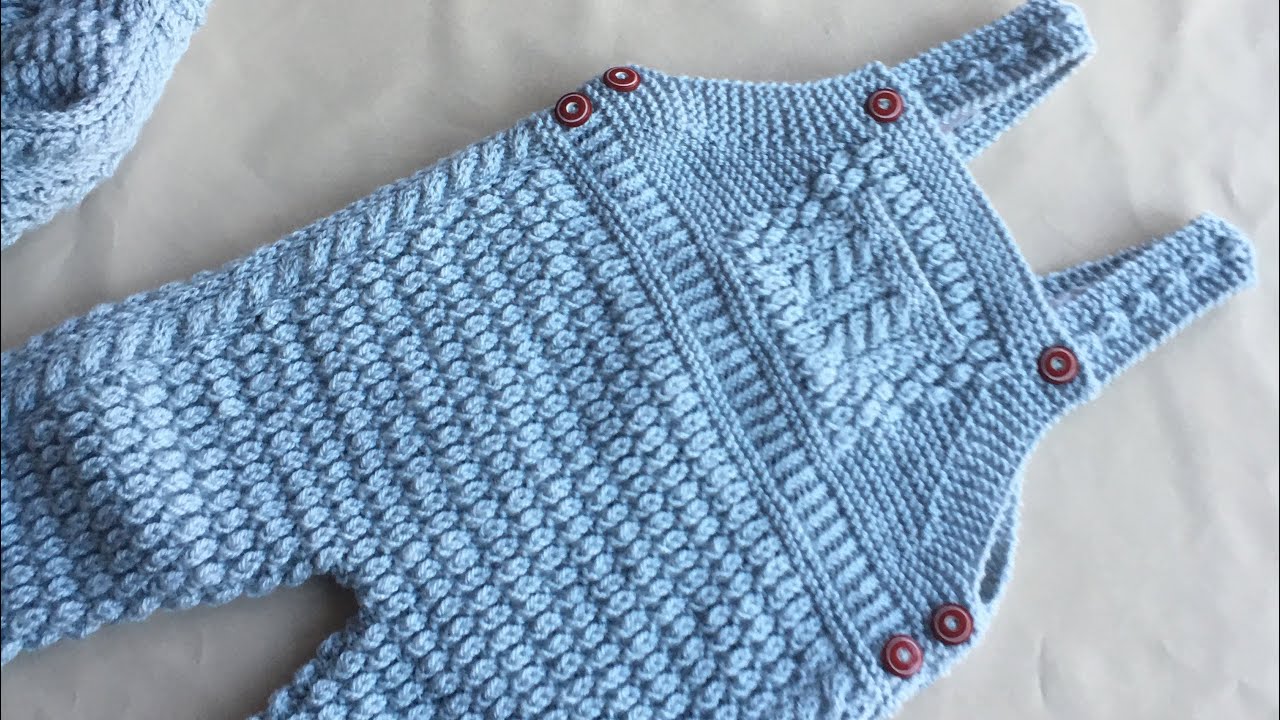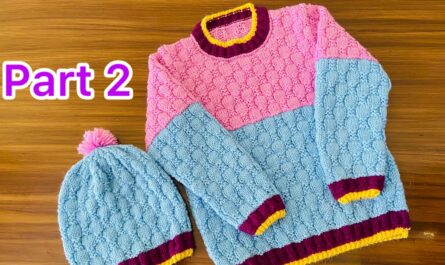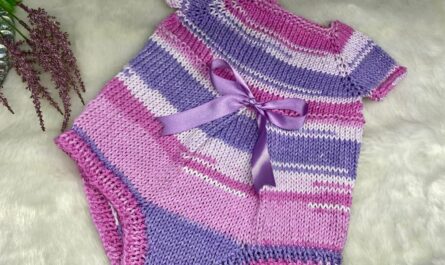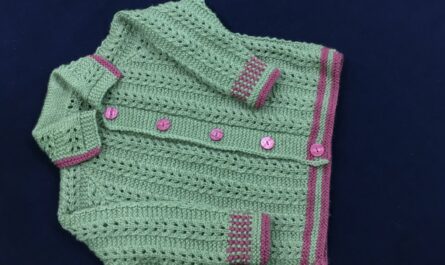Imagine your active one-year-old, busy crawling, cruising, or taking their first wobbly steps, clad in a cozy, hand-knitted dungaree. This iconic garment offers unparalleled comfort and freedom of movement, making it a perfect choice for their inquisitive nature. A hand-knitted dungaree is not just clothing; it’s a statement of classic charm, practical design, and heartfelt warmth, providing full coverage without restrictive waistbands.
While knitting a dungaree (also known as overalls or romper) involves multiple sections, it’s a highly rewarding project for an intermediate knitter or an adventurous beginner ready to learn new techniques. This detailed article will guide you through the process of creating a beautiful hand-knitted dungaree for a 1-year-old, covering essential considerations, common construction methods, key design elements, and tips for success.
Why Knit Dungarees for a 1-Year-Old?

- Ultimate Comfort & Mobility: Dungarees provide unrestricted movement, essential for a rapidly developing one-year-old. There are no tight elastic waistbands to dig in, and they ensure their tummy and back stay covered during active play.
- Practicality: They are excellent for layering over bodysuits, t-shirts, or sweaters. Adjustable straps accommodate growth, and easy-access closures are a lifesaver for diaper changes.
- Adorableness Factor: Dungarees evoke a timeless, nostalgic charm that is simply irresistible on a little one. They make for truly precious photos!
- Thoughtful Gift: A handmade dungaree is a unique, practical, and deeply personal gift that will be treasured by parents and child alike, often becoming a cherished heirloom.
- Skill Building: Tackling a dungaree allows knitters to hone their skills in garment construction, including knitting separate pieces (legs), joining in the round, working shaping, creating plackets, and adding closures.
- Durability: With the right yarn choice and pattern, a hand-knitted dungaree can be incredibly robust, ready to withstand countless adventures and washes.
Key Considerations for Design & Yarn (1-Year-Old Specifics):
The specific needs of a one-year-old heavily influence yarn and design choices.
- The 1-Year-Old Factor:
- Active & Mobile: The garment needs to be stretchy and allow maximum freedom for crawling, climbing, and walking. Ensure ample positive ease (room to move).
- Growing Rapidly: While knitwear is forgiving, choose a pattern that allows for some growth, and adjustable straps are a major bonus for longer wear.
- Messy Explorers: This is paramount: Your chosen yarn must be machine washable and durable enough to withstand frequent laundry cycles.
- Diaper Changes: Easy access to the diaper area is crucial. Patterns with snaps or buttons along the inner leg or crotch are highly recommended.
- Developing Personality: At this age, you can start incorporating more vibrant colors or simple motifs that might appeal to a child’s emerging preferences.
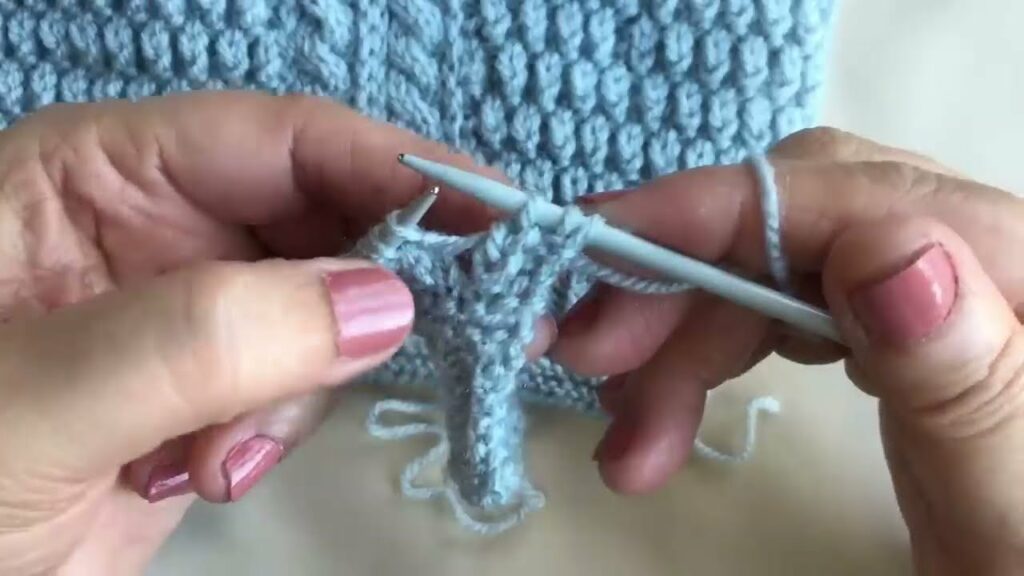
- Yarn Choice (Utmost Importance!):
- Fiber:
- Superwash Merino Wool: Often considered the gold standard for baby knitwear. It’s incredibly soft, warm yet breathable, offers excellent elasticity (important for fit and movement), and is machine washable without felting.
- Organic Cotton / Cotton Blends: Ideal for sensitive skin, warmer climates, or if you prefer plant-based fibers. They are durable, breathable, and usually machine washable. While cotton has less elasticity than wool, choosing a pattern with ribbing or textured stitches can compensate.
- Baby-Specific Acrylics / Blends: Modern, high-quality acrylics can be surprisingly soft, hypoallergenic, affordable, durable, and very machine washable. Blends (e.g., acrylic with a percentage of merino or cotton) combine the best attributes of different fibers.
- Weight:
- DK (Double Knitting) or Worsted Weight: These are the most common and often ideal choices for dungarees. They work up at a reasonable pace, provide excellent stitch definition for texture, and offer comfortable warmth without being bulky for active play.
- Color Palette: For a 1-year-old, you can move beyond traditional pastels.
- Earth Tones: Sage green, mustard yellow, rust, terracotta, soft browns, oatmeal, charcoal.
- Soft Jewel Tones: Muted berry, sapphire, emerald green, lavender.
- Classic Primary Colors: Bold red, blue, yellow.
- Stripes: Fun and classic, whether subtle tone-on-tone or vibrant multi-color.
- Variegated/Self-Striping: These yarns create effortless color changes and visual interest.
- Safety: Always choose yarn that is machine washable and hypoallergenic.
- Fiber:
- Sizing (1 Year Old / 12 Months):

- Patterns will provide specific finished measurements (e.g., chest/hip circumference, full length) for the 1-year-old size. A typical 1-year-old’s chest/hip circumference is around 18-20 inches (45-51 cm).
- Positive Ease: Dungarees are designed to be roomy for comfort and movement, so expect significant positive ease (often 3-6 inches / 7.5-15 cm) compared to the child’s actual measurements.
- The All-Important Gauge Swatch: This is the single most critical step for any knitted garment.
- Knit a generous swatch (at least 6×6 inches / 15×15 cm) in the main stitch pattern of your dungaree.
- Wash and block your swatch exactly as you plan to treat the finished garment. This is vital, as yarn can change after washing.
- Measure your stitches and rows per inch/cm precisely.
- Adjust your needle size (up if your knitting is too tight/too many stitches; down if too loose/too few stitches) and re-knit until your swatch matches the pattern’s gauge.
- Closure:
- Straps: The most common closure is buttonholes on the straps that button onto the front bib. Ensure buttons are securely sewn.
- Crotch/Inner Leg: Snaps are highly recommended for easy diaper changes. They are quick and flat. Buttons can also be used, but are less convenient for frequent changes.
- Side Buttons (Optional): Some patterns include buttons on the sides of the waistband for even easier dressing.
Common Construction Methods:
Dungarees are most frequently knit using a bottom-up approach.
- Bottom-Up (Seamless or Seamed):
- How it works: You typically begin by knitting each leg separately (either in the round or flat and then seamed). Once the legs reach the crotch, they are joined onto a single circular needle, and the body of the dungaree is knit upwards. The bib and back panel are then created, and finally, the straps are knit or picked up and knit.
- Seamless Pros: Creates a comfortable garment with no bulky side seams, ideal for active wear.
- Seamless Cons: Joining the legs can be tricky for beginners.
- Seamed Pros: Can be knit flat on straight needles, potentially easier for some new knitters.
- Seamed Cons: Requires precise seaming, which can be time-consuming.
- Top-Down:
- While less common for full dungarees, some patterns adapt this method (often for jumpsuit-style rompers), starting at the bib/yoke and knitting downwards. This requires more complex shaping to divide and create the legs.
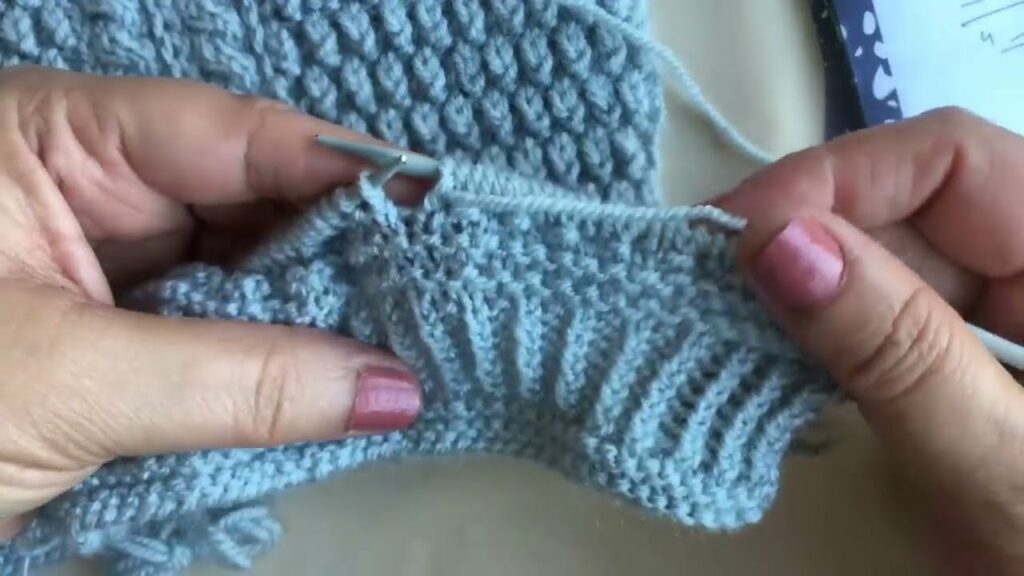
Basic Elements & Popular Stitch Patterns:
A good dungaree pattern will guide you through these essential techniques:
- Stitches to Know: Cast On, Knit (K), Purl (P), Ribbing (1×1 or 2×2), Bind Off.
- Shaping: Increases (KFB, M1L/R) for shaping the body, and decreases (K2tog, SSK) for crotch shaping or leg tapering.
- Buttonholes: Learning to create neat horizontal or vertical buttonholes on the bib and straps.
- Picking Up Stitches: For creating straps from the main body, or neat edgings around armholes.
- Joining in the Round: For seamless construction.
- Pattern Structure: A reliable pattern will clearly list materials, gauge, finished measurements, abbreviations, and step-by-step instructions for each section.
- Popular Stitch Patterns for Dungarees:
- Garter Stitch: (Knit every row/round). Very squishy, soft, reversible, and prevents curling. Excellent for the main body for comfort and durability.
- Stockinette Stitch: (Knit right side, purl wrong side; or knit every round). Smooth, classic. If used for the main body, ensure edges are stabilized to prevent curling.
- Moss Stitch / Seed Stitch: (Alternating K and P stitches within the row). Creates a lovely, subtle texture, lies flat, and is very durable. Great for bibs, edgings, and straps.
- Ribbing (1×1 or 2×2): Essential for leg cuffs and armhole bands for elasticity and neatness.
- Simple Cables: Very small, repeating cable patterns can add textural interest to the bib or down the side of the body.
- Textured Stripes: Easy to create by alternating bands of knit and purl rows (e.g., stockinette and garter stitch bands) for visual interest.
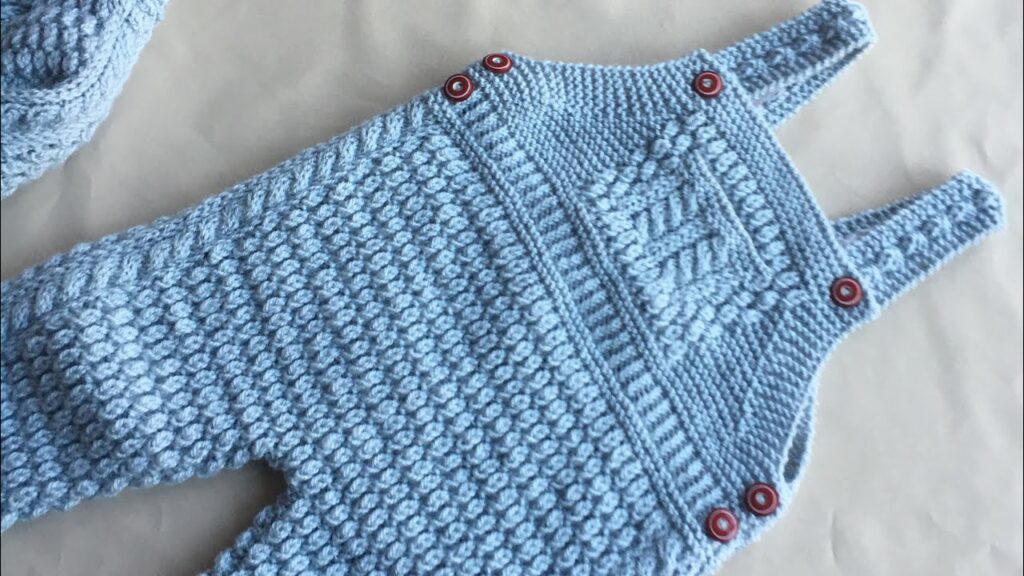
Key Design Elements for 1-Year-Old Dungarees:
- Bib: The iconic front panel, often decorated with simple motifs or texture.
- Body: The main section, designed with positive ease to accommodate movement and layering.
- Legs: Can be full-length for warmth or short “romper” style for warmer weather. Ribbed cuffs are common for a snug fit.
- Crotch/Inner Leg Opening: Absolutely essential for quick diaper changes. Typically secured with snaps (most convenient) or buttons.
- Straps: Adjustable length with buttonholes, usually crossing at the back for security.
- Pockets (Optional): Small patch pockets on the bib or back are functional (for tiny treasures!) and incredibly cute.
- Animal Ears/Motifs (Optional): Some playful designs include knitted animal ears on the bib or simple intarsia/duplicate stitch animal faces.
Step-by-Step (Simplified) Outline of a Bottom-Up Seamless Dungaree:
This is a general guide; your chosen pattern will provide exact stitch counts and specific instructions.
- Prepare: Gather your pattern, yarn, circular needles, DPNs (or long circular for Magic Loop if knitting small circumference), stitch markers, tapestry needle, and scissors.
- Knit Your Gauge Swatch: This step is crucial for accurate sizing. Wash, block, and measure it. Adjust needle size if needed.
- Knit the Legs:
- Cast on for one leg, work a few rounds of ribbing for the cuff.
- Switch to your main stitch pattern and knit the leg in the round (or flat) until it reaches the crotch length.
- Repeat for the second leg.
- Join Legs & Knit Body:
- Place both legs onto one long circular needle.
- Join them together in the round, often by casting on a few stitches at the inner crotch to create a seam for strength.
- Continue knitting the main body in the round until it reaches the desired length for the armholes/bib division.
- Divide for Bib & Back:
- At the armholes, you will divide the body stitches into sections for the front bib and the back panel.
- You will now knit the front bib and back panel separately, often flat, shaping the armholes and necklines as per the pattern.
- Knit Bibs/Panels & Straps:
- Continue knitting the front bib and back panel up to the top. Shape the neckline and armholes.
- Create the straps: These can be knit directly from the top edges of the bib/back, or knit separately as I-cords or flat bands and then sewn on. Create buttonholes on the straps.
- Finishing:
- Weave in Ends: Neatly weave in all loose yarn tails using a tapestry needle.
- Sew on Buttons/Apply Snaps: Securely sew on the strap buttons and apply snaps along the crotch/inner leg.
- Block: Gently wash your finished dungaree according to your yarn’s care instructions. Gently squeeze out excess water. Lay it flat on a towel or blocking mats, shaping it to the correct dimensions from the pattern. Let it air dry completely. Blocking significantly improves the drape and overall appearance of the garment.
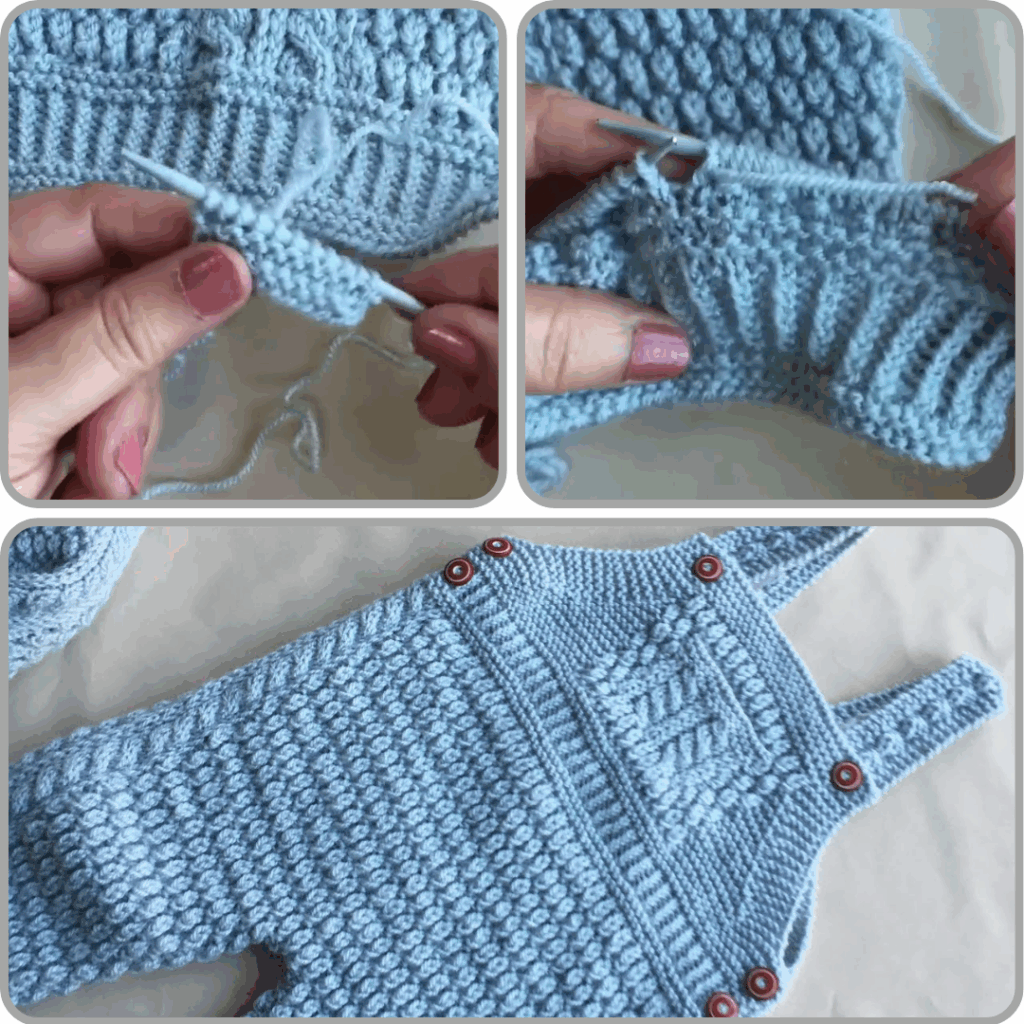
Tips for Intermediate Success:
- Read the Entire Pattern First: For multi-section garments like dungarees, a full read-through helps you visualize the construction and anticipate any new techniques or tricky parts.
- Watch Video Tutorials: For any specific techniques you’re unsure about (e.g., joining legs in the round, a particular type of buttonhole, picking up stitches).
- Use Stitch Markers! They are invaluable for marking the beginning of rounds, stitch pattern repeats, and shaping points.
- Don’t Fear Mistakes: They are part of the learning process! A good seam ripper or simply unraveling a few rows is always an option.
- Baby Safety First: Ensure all buttons and snaps are sewn/applied extremely securely. Avoid any long ties or very small, loose embellishments that could pose a choking hazard.
Video Tutorial :
Knitting a dungaree for a 1-year-old is a highly rewarding project that combines thoughtful design with practical functionality. The result is a beloved garment, full of comfort, style, and the immeasurable warmth of handmade love. Happy knitting! Sources
